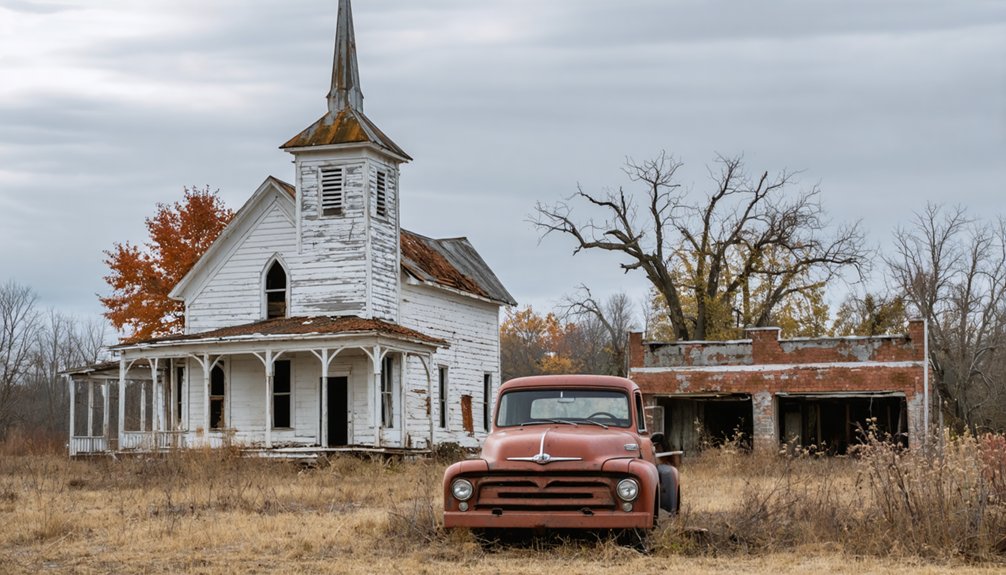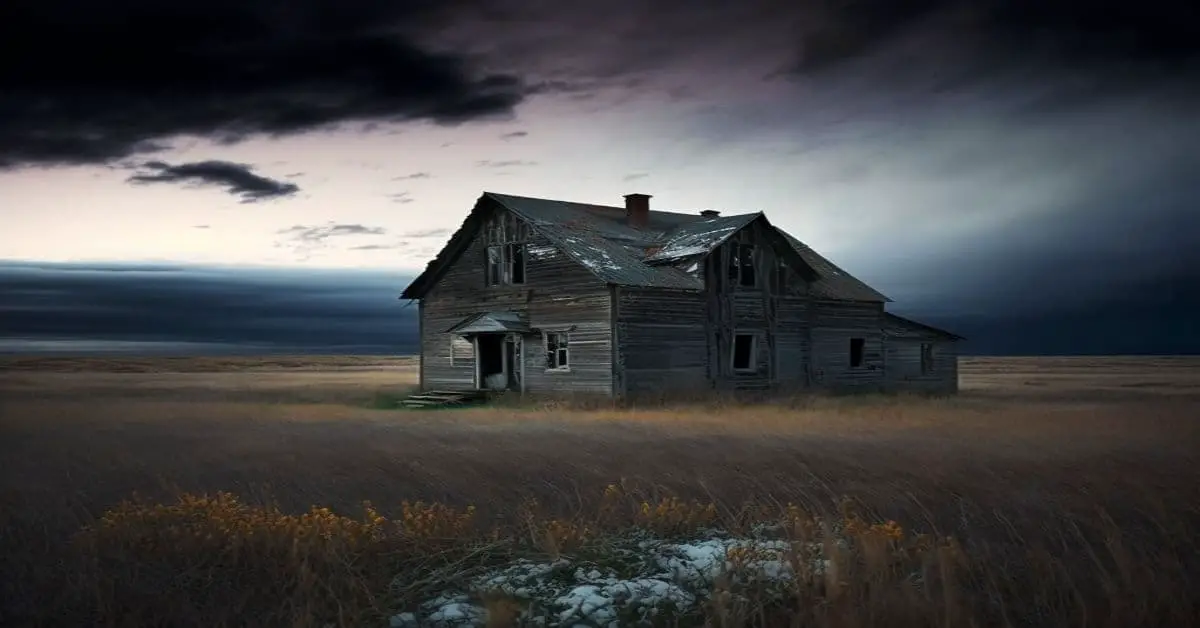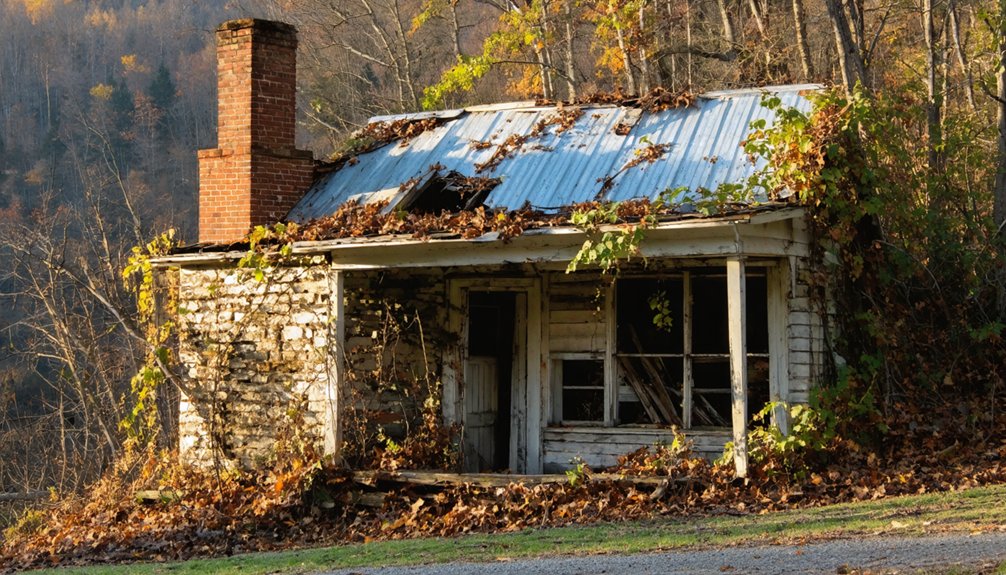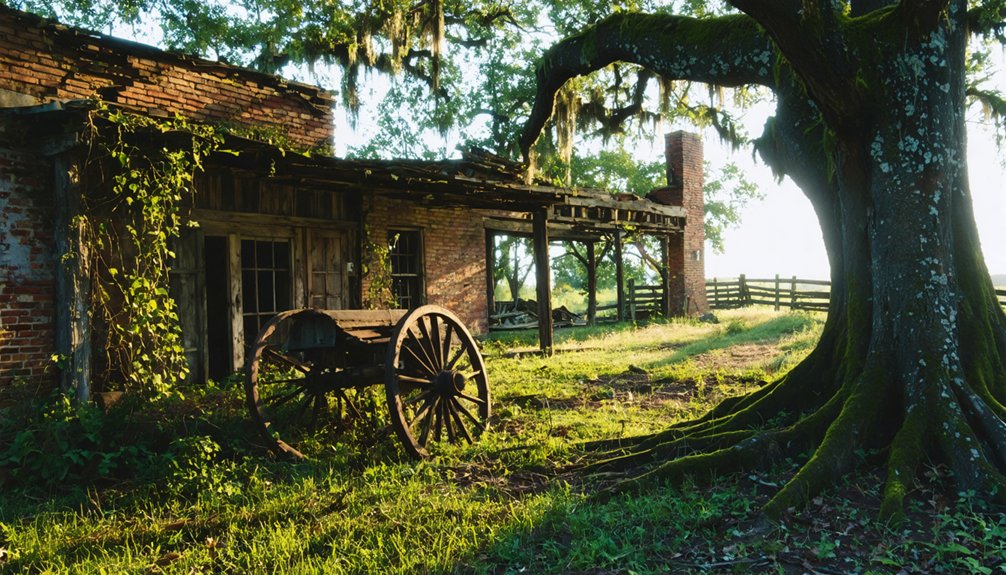You’ll find Moscow, Arkansas in Jefferson County, where it emerged as a strategic railroad stop in the late 19th century. Named after Russia’s capital, this once-bustling town thrived along the Missouri Pacific Railroad line, featuring the historic Moscow General Store and serving local agricultural trade. After Confederate forces attacked in 1864 and the railroad eventually bypassed the town, Moscow’s decline began. Today, abandoned structures and the old cemetery tell a deeper story of Arkansas’s railroad past.
Key Takeaways
- Moscow, Arkansas was established during the late 19th century railroad expansion as a strategic stop along the Missouri Pacific Railroad line.
- The town experienced severe decline after being bypassed by the Cairo and Fulton Railroad, leading to its eventual abandonment.
- The historic Moscow General Store remains as the most significant standing structure, symbolizing the town’s former prominence.
- Economic hardships, population exodus to urban centers, and closure of essential services like the post office contributed to Moscow’s ghost town status.
- The abandoned town now serves as a historical reminder of Arkansas’s railroad era, with numerous deteriorating 19th and 20th-century structures.
The Ghost Town’s Historical Origins
Founded during the railroad expansion era of the late 19th century, Moscow, Arkansas emerged as a strategic stop along the Missouri Pacific Railroad line. You’ll find that the town’s establishment directly resulted from this railroad connection, which attracted settlers and entrepreneurs seeking opportunities in this new frontier.
Named after Russia’s capital city, Moscow quickly developed into a bustling community centered around rail commerce. Business gradually declined after the railroad bypass occurred, forcing many residents to seek opportunities elsewhere. Similar to the zinc mining town of Rush, Moscow faced significant population decline when its primary industry faltered.
At the heart of town stood the general store, built in 1884, which served as a crucial community hub where locals and travelers alike gathered. This cornerstone business has remarkably survived since its founding, offering a glimpse into Moscow’s prosperous beginnings.
As rail traffic increased, the town flourished with various enterprises catering to agricultural needs and transportation services.
Location and Geographic Features
Located in Jefferson County, Arkansas, Moscow sits approximately 13 miles southeast of Pine Bluff at the junction of U.S. Route 65 and Arkansas Highway 199.
You’ll find this ghost town nestled within a rural landscape that’s characteristic of the region’s geographic features, including mixed forests and agricultural lands. Like many abandoned Arkansas towns, Moscow reflects the economic changes that impacted rural communities over time.
The area’s terrain showcases typical Arkansas topography, with scattered streams and creeks winding through the countryside. While you won’t find any major water bodies nearby, the surrounding environment supports diverse wildlife, including deer and various bird species. This unincorporated community maintains minimal signs of its past settlement.
The region experiences a humid subtropical climate, making it susceptible to severe thunderstorms and occasional tornadoes. The sparsely populated community is surrounded by natural vegetation, with dense forests and grasslands dominating the scenery.
Notable Structures and Remnants
Within Moscow’s rural landscape, the historic Moscow General Store stands as the most prominent reminder of the town’s vibrant past. Built in 1884, it’s the only commercial building still operating today, serving as a living connection to the railroad boom era that shaped the community.
As you explore the ghost town, you’ll discover numerous abandoned structures from the late 19th and early 20th centuries, each telling a story of Moscow’s former significance. While architectural styles reflect the town’s railroad-driven prosperity, most buildings now showcase the natural weathering of time. Like the preserved mining structures at Rush Ghost Town, these buildings provide valuable historical context. Similar to many Arkansas communities, the town experienced a decline for unknown reasons.
Despite minimal preservation efforts, these silent structures – from old homes to railroad-related buildings – create an atmospheric journey through Arkansas history. The town remains frozen in time, offering a genuine glimpse into a bygone era of American expansion.
Life in Early Moscow
If you’d lived in early Moscow, you’d have spent your days working in agriculture, growing corn and raising pork for both local consumption and broader markets connected by the Missouri Pacific Railroad.
Your daily routines would’ve centered around farming activities, with trips to local trading posts and markets to sell produce and purchase supplies.
You might’ve gathered with other community members at spots near the railroad depot, which served as both a commercial hub and social meeting place for Moscow’s mainly rural population.
Like many communities in Arkansas during this period, Moscow residents would have faced significant economic hardships during the post-Civil War era when the region struggled to maintain its agricultural base.
The early settlers likely interacted with the Quapaw tribe, who had established trading relationships with European settlers in the region since the late 1600s.
Daily Routines and Activities
Life in early Moscow revolved around the steady rhythm of railroad schedules and agricultural demands.
You’d start your day with essential daily chores – fetching water, tending to livestock, and preparing for work either on the railroad or in nearby fields. During harvest seasons, you’d join your neighbors in shared labor, strengthening community bonds while ensuring everyone’s crops made it to market.
Like the residents of zinc mining communities elsewhere in Arkansas, the townspeople worked hard to build a thriving local economy. While Moscow was once bustling, it gradually became a neglected site as people moved away.
Evenings brought family gatherings around the dinner table, where you’d share stories and plan for tomorrow’s tasks.
If you were a child, you’d split your time between helping at home and attending the local one-room schoolhouse, though education often took a back seat during planting and harvest times.
The general store and railroad depot served as social hubs where you’d catch up on local news and connect with neighbors.
Trade and Commerce Markets
Trading in early Moscow centered on agricultural goods and natural resources, with farmers like you bringing corn, cotton, and timber to informal marketplace areas near central crossroads.
You’d find barter systems thriving as locals exchanged flour, sugar, and tools for crops or labor. The blacksmith’s shop served as an essential trading hub where you could get your tools repaired while conducting business.
The market dynamics shifted with the seasons, and you’d see general stores stocking imported essentials like coffee, fabric, and kerosene.
If you needed credit, store owners often extended loans until your crops sold. Local craftsmen – coopers, cobblers, and carpenters – maintained important supply chains, while seasonal fairs drew traders from surrounding areas, though limited transportation routes kept commerce primarily regional.
Community Gathering Places
Beyond the bustling markets, Moscow’s social fabric wove through several key gathering places that shaped daily life in the late 1800s.
You’d find the railroad depot humming with activity as travelers exchanged news and telegrams, while the Missouri Pacific trains connected Moscow to the wider world.
The Moscow General Store, built in 1884, wasn’t just for shopping – it’s where you’d catch up on local happenings and join informal community events.
The Moscow Church and Cemetery served as centers for spiritual life, hosting everything from weddings to Decoration Days.
While no specific school records exist, you’d likely find residents gathering at front porches, rail yards, and churchyards for impromptu social interactions that kept the community connected during the town’s railroad-era peak.
The Path to Abandonment
Moscow’s decline began with its inability to attract major industrial development, leaving it dependent on increasingly unstable agricultural markets.
You’ll find that the lack of railroad access and major transportation routes severely limited the town’s growth potential through the late 1800s and early 1900s.
The steady exodus of residents to larger urban centers, coupled with the closure of essential institutions like the post office, marked Moscow’s inevitable path toward abandonment by the mid-20th century.
Economic Downturn and Decline
Although the exact timeline remains unclear, the economic decline of Moscow, Arkansas followed a pattern common to many small American towns facing industrial challenges.
You’d find that several economic factors contributed to Moscow’s downfall, including its heavy dependence on local industries and limited economic diversification. When market demands shifted and technological advancements emerged, the town struggled to adapt.
The industry decline created a domino effect: job losses led to reduced consumer spending, which forced local businesses to close. As residents moved away seeking better opportunities, housing values plummeted and essential services diminished.
The town’s isolation and infrastructure challenges made it difficult to attract new investments or industries. Without significant government intervention or community-driven initiatives to diversify the economy, Moscow’s fate was sealed, leading to its eventual abandonment.
Population Exodus Timeline
When the Civil War swept through Moscow, Arkansas in 1864, it marked the beginning of the town’s gradual depopulation.
You’ll find that after Confederate forces attacked Union troops on April 13, the town’s population growth stalled considerably.
Following the war’s end, you can trace how residents began leaving the settlement, discouraged by limited economic prospects and the lack of infrastructure development.
Migration patterns show that families moved to more promising areas, leaving Moscow’s agricultural lands underutilized.
The exodus accelerated as existing structures fell into disrepair, and the once-bustling stagecoach stop along the Camden to Washington road lost its significance.
Transportation Routes Shifted
The decline of Moscow’s population coincided with major changes in regional transportation networks.
You’d have found Moscow initially positioned along a crucial stagecoach route between Camden and Washington, where travelers relied on horse-drawn transport moving at just two miles per hour.
This transportation evolution hit Moscow hard when the Cairo and Fulton Railroad bypassed the village.
The rail impact was devastating – while towns along the new railway flourished, Moscow lost its strategic position in the region’s transport system.
You’d no longer see the steady stream of travelers, freight, and mail that once sustained the village’s economy.
The old stagecoach road, once Moscow’s lifeline, fell into disrepair as rail became dominant.
Without maintenance and regular traffic, the village’s isolation grew, sealing its fate as businesses and residents sought opportunities elsewhere.
Exploring Moscow Today
Located 13 miles southeast of Pine Bluff, modern-day Moscow stands as a tribute to Arkansas’s railroad history, offering visitors a genuine ghost town experience.
Step back in time at Moscow, Arkansas, where abandoned railway structures tell silent stories of the state’s historic past.
You’ll find this rural exploration destination near the junction of U.S. Route 65 and Arkansas Highway 199, where the historic Moscow General Store, built in 1884, still operates.
While exploring the town’s weathered structures, you’ll notice the minimal infrastructure and quiet surroundings that characterize this preserved slice of the past.
- Walk among original buildings frozen in time, with few modern alterations disrupting the authentic atmosphere
- Visit the operational Moscow General Store, a living connection to the town’s vibrant past
- Experience the solitude of a once-bustling railroad community, now perfect for self-guided exploration
Remember to bring necessities, as you won’t find modern amenities or tourist facilities in this untouched ghost town setting.
Legacy and Historical Significance
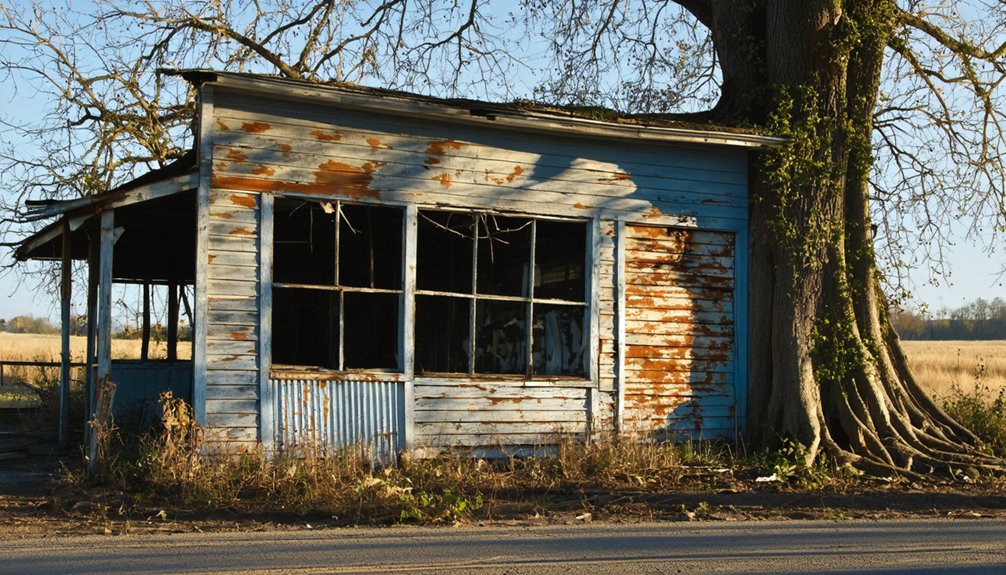
Perseverance through change defines Moscow’s enduring legacy as a reflection of Arkansas’s rural history.
You’ll find the town’s cultural significance deeply rooted in its Methodist church and cemetery, which continue to stand as preserved relics of a once-thriving farming community. These landmarks tell the story of Moscow’s evolution from an agricultural hub near major transport routes to its gradual decline amid economic shifts and urbanization.
Despite the challenges of maintaining rural structures, preservation efforts have helped protect the Moscow Methodist Church, ensuring that future generations can connect with the area’s past.
The church’s role as a gathering place, along with its historical artifacts, provides valuable insights into community life and local traditions that shaped this corner of Arkansas during the 19th century.
Frequently Asked Questions
Are There Any Paranormal Activities Reported in Moscow, Arkansas?
You won’t find documented ghost sightings or haunted locations in Moscow, Arkansas. Unlike other Arkansas ghost towns that boast paranormal activity, this quiet town’s history doesn’t include any verified supernatural encounters.
What Wildlife Species Can Visitors Commonly Encounter in the Area?
You’ll spot great opportunities for wildlife photography with coyotes, foxes, bobcats, and armadillos. Bird watching enthusiasts can find bald eagles, herons, kingfishers, and over 400 native bird species.
Is Camping or Overnight Stays Allowed Near Moscow’s Remains?
You can’t legally camp or stay overnight near Moscow’s remains. Current camping regulations prohibit unauthorized stays, and there aren’t any designated overnight accommodations in the area without landowner permission.
What Are the Best Seasons and Weather Conditions for Visiting?
Crisp autumn leaves crunch beneath your feet during the best time to visit – spring (April-June) and fall (September-October). You’ll enjoy temperatures between 65-85°F with moderate humidity and pleasant hiking conditions.
Are Metal Detectors or Artifact Collection Permitted in Moscow?
You’ll need explicit landowner permission for metal detecting since current regulations restrict artifact collection. If it’s public land, you’re prohibited from removing historical items under preservation guidelines.
References
- https://en.wikipedia.org/wiki/List_of_ghost_towns_in_Arkansas
- https://www.jstor.org/stable/40018761
- https://kids.kiddle.co/List_of_ghost_towns_in_Arkansas
- https://arkansasfrontier.com/ghost-towns-in-arkansas/303766/
- https://www.onlyinyourstate.com/experiences/arkansas/ar-ghost-towns
- https://onlyinark.com/places-and-travel/rush-arkansas-ghost-town/
- http://freepages.rootsweb.com/~gtusa/history/usa/ar.htm
- https://www.youtube.com/watch?v=3oZuUMZk_Eo
- https://www.thetravel.com/ghost-towns-in-arkansas/
- https://www.barefoottraveler.com/rush.html
